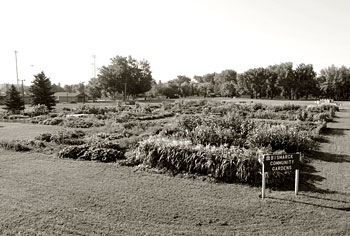
Bismarck Community GardenIn towns and cities, community gardens required a group sponsor or a school sponsor. Someone had to take the role of weed supervisor and organize the gardeners to protect the vegetables from vandalism. NWSL or Block Leaders also had to locate water, a tractor with a disc to dig up the garden space, and mark out 50 ft x 50 ft gardens. Each of these garden plots was expected to feed a family of 5. Each family had to pay $3 annual rent for use of the plot.
In support of Victory Gardens, Governor Moses made a timely radio address on WDAY (Fargo) and KFYR (Bismarck) on April 30, 1943. The report stated that these two radio stations would cover all of ND. While he urged listeners to plan a garden, he used data to show how well North Dakota did with its Victory Gardens in 1942. Seed sales had risen 39%; vegetable canning in rural areas was up 142%. But it wasn’t enough, Moses said. More people should garden and every garden should include eight to ten varieties of vegetables. Every family should put up 100 to 125 quarts of vegetables for winter consumption. Every farm (74,000) should have an adequate garden. At least 51,000 urban families should have a garden. Home gardens can have a major impact on the war effort: soldiers will have more food, home canned vegetables will not be deducted from rations, home-raised vegetables save on shipping space. Moses encouraged gardeners to share their surplus with their neighbors.




